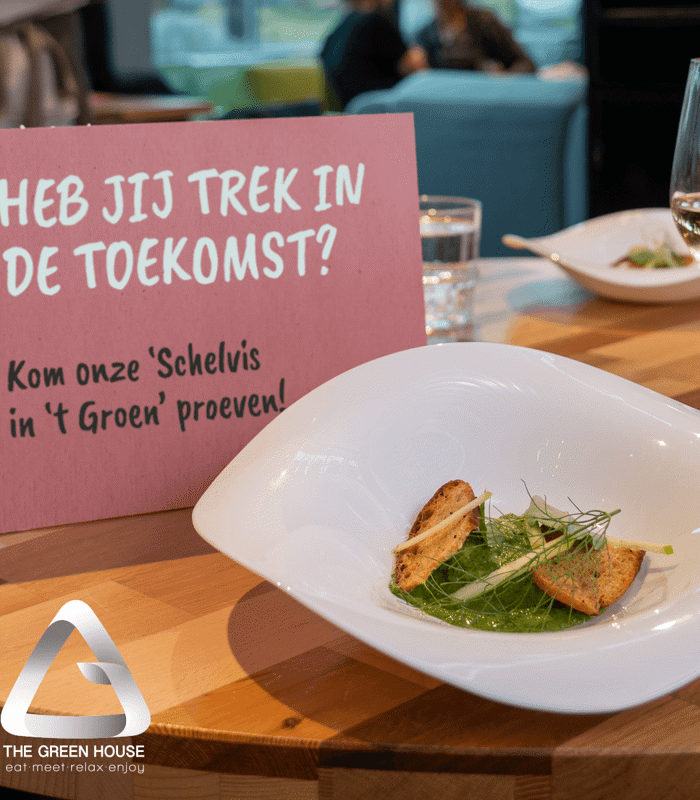There are currently 3 special dishes on the menu of restaurant The Green House in Utrecht, created by 4 students of the Food Innovation study programme of HAS University of Applied Sciences and 2 students of the Hotel Management School Maastricht. The students developed the dishes within the minor Gastronomy and together they form 'the menu of the future' at The Green House.
This menu is the result of a sustainable dish contest within a minor at the Hotel Management School Maastricht, which finished just before the end of the summer holidays. In pairs, the students who followed the minor created a dish which is as sustainable as possible, containing a maximum of 150 kcal. They had to take into account the amount of CO2 equivalents, land use (biodiversity), nutritional value and health. A professional jury including Ernest van de Voort, Peter Scholte and Peter Klosse judged the dishes. Three dishes won a place on the menu of Albron's circular restaurant, The Green House, where they can now be tasted:
- Schelvis in 't Groen (Haddock in Green) by Jitske Strolenberg and Mauk Meijers from the Food Innovation study programme at HAS University of Applied Sciences:
- Red beet ravioli by Noa Roos and Marlies Samson from the Food Innovation study programme at HAS University of Applied Sciences:
- Carrot tartar by Isabelle Steiner and Claartje Verschoor of the Hotel Management School Maastricht:
Jitske Strolenberg and Mauk Meijers study Food Innovation at our site in Venlo and tell a short story about their experiences.
How did you come up with the idea for the Schelvis in 't Groen?
Jitske: “A classic Flemish dish was our inspiration, namely 'eel in green': fresh eel cooked in a sauce of green herbs and vegetables. Eel stocks are not very high at the moment, so we were looking for a sustainable alternative: this turned out to be haddock. This is a bycatch in commercial fisheries that used to be thrown back into the sea, but this is now banned. That is why the fish are often exported or destroyed. And meanwhile, fish with less flavour, such as tilapia, is imported from Asia. We thought this was a waste.”
Mauk: “For the assignment we had to take into account, among other things, CO2 equivalents and land use. A fish uses almost no land and emits very little. What's more, you can use almost all of a fish in a dish from a culinary point of view. We wanted our dish to generate as little waste as possible and, in addition, we only wanted to use ingredients from Dutch soil. And it worked. The dish is also healthy: haddock contains a lot of proteins and a small amount of fats. The vegetables and herbs for the sauce contain a lot of fibres. And green herbs are also good for your resistance as well as a good salt substitute.”
Why did you choose the minor Gastronomy?
Mauk: “I am very passionate about gastronomy and cooking. Alongside my studies, I have been working as a chef de partie at restaurant Fitz Roy in Maastricht for several years. When I started the minor, I already had quite a bit of knowledge about different flavour combinations and preparation techniques. Knowledge about wine-food combinations was still lacking and I wanted to learn more about that. Now that I have had a taste of this and have the basic knowledge, I want to develop myself even more in this area.”
Jitske: “Unlike Mauk, I didn't have a lot of product knowledge and knowledge about flavour combinations. This is something I really wanted to learn. In addition, wine and food combinations were also discussed and I found this very interesting. I think it is important to know what certain factors have an effect on nutrition and also on the guest's experience, and a lot of focus was placed on that during this minor.”
How do you look back on your 'adventure' in Maastricht?
Mauk: “I really enjoyed being away from my usual surroundings for a while and getting to know new people. It is also interesting to see how things are going at another school. I would recommend it to anyone to do a minor at another university of applied sciences. Since I live in Maastricht, it was also a home game for me. The only drawback was that, because of corona, a lot of things took place digitally, so I only had a limited feeling of really having spent 10 weeks at another school.”
Jitske: “The Hotel Management School Maastricht is very different from HAS University of Applied Sciences in Venlo. I really enjoyed being taught at another school using different methods. In addition, most teachers did not start their careers as teachers, but have years of experience in the food world. This made the lessons very interesting. I definitely learned a lot. Winning the sustainable dish contest has given us great opportunities and has expanded our network within the food world. I never thought this would happen when I started this minor.”




